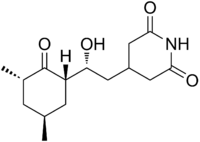- Cycloheximide
-
Cycloheximide  4-[(2R)-2-[(1S,3S,5S)-3,5-Dimethyl-2-oxocyclohexyl]-2-hydroxyethyl]piperidine-2,6-dioneOther namesnaramycin a, hizarocin
4-[(2R)-2-[(1S,3S,5S)-3,5-Dimethyl-2-oxocyclohexyl]-2-hydroxyethyl]piperidine-2,6-dioneOther namesnaramycin a, hizarocin
actidione, actispray
kaken, U-4527Identifiers CAS number 66-81-9 
PubChem 6197 ChemSpider 5962 
UNII 98600C0908 
KEGG C06685 
ChEBI CHEBI:27641 
ChEMBL CHEMBL123292 
RTECS number MA4375000 Jmol-3D images Image 1 - O=C2NC(=O)CC(C[C@@H](O)[C@H]1C(=O)[C@@H](C)C[C@H](C)C1)C2
- InChI=1S/C15H23NO4/c1-8-3-9(2)15(20)11(4-8)12(17)5-10-6-13(18)16-14(19)7-10/h8-12,17H,3-7H2,1-2H3,(H,16,18,19)/t8-,9-,11-,12+/m0/s1

Key: YPHMISFOHDHNIV-FSZOTQKASA-N
InChI=1/C15H23NO4/c1-8-3-9(2)15(20)11(4-8)12(17)5-10-6-13(18)16-14(19)7-10/h8-12,17H,3-7H2,1-2H3,(H,16,18,19)/t8-,9-,11-,12+/m0/s1
Key: YPHMISFOHDHNIV-FSZOTQKABD
Properties Molecular formula C15H23NO4 Molar mass 281.35 g/mol Appearance colourless crystals Melting point 119.5–121 °C
Hazards MSDS Oxford MSDS EU classification Toxic (T) R-phrases R26 R27 R28  (verify) (what is:
(verify) (what is:  /
/ ?)
?)
Except where noted otherwise, data are given for materials in their standard state (at 25 °C, 100 kPa)Infobox references Cycloheximide is an inhibitor of protein biosynthesis in eukaryotic organisms, produced by the bacterium Streptomyces griseus. Cycloheximide exerts its effect by interfering with the translocation step in protein synthesis (movement of two tRNA molecules and mRNA in relation to the ribosome) thus blocking translational elongation. Cycloheximide is widely used in biomedical research to inhibit protein synthesis in eukaryotic cells studied in vitro (i.e. outside of organisms). It is inexpensive and works rapidly. Its effects are rapidly reversed by simply removing it from the culture medium.
Due to significant toxic side effects, including DNA damage, teratogenesis, and other reproductive effects (including birth defects and toxicity to sperm[1]), cycloheximide is generally used only in in vitro research applications, and is not suitable for human use as a therapeutic compound. Although it has been used as a fungicide in agricultural applications, this application is now decreasing as the health risks have become better understood.
Cycloheximide is degraded by alkali (pH > 7), decontamination of work surfaces and containers can be achieved by washing with a non-harmful alkali solution such as soap.
Since cycloheximide is an effective inhibitor of protein biosynthesis in eukaryotes only, it may be used to distinguish between proteins translated in the mitochondria and proteins translated in the cytosol. mRNA translated in cytosol or ER from mRNA derived from the nucleus will not be expressed in the presence of cycloheximide. Conversely, translation using mitochondrial ribosomes is unaffected by cycloheximide, and mitochondrial genes will continue to be expressed.
Experimental applications
Cycloheximide can be used as an experimental tool in molecular biology to determine the half-life of a protein. Treating cells with cycloheximide in a time-course experiment followed by Western blotting of the cell lysates for the protein of interest can show differences in protein half-life. Cycloheximide treatment provides the ability to observe the half-life of a protein without confounding contributions from transcription or translation.
It is used as a plant growth regulator to stimulate ethylene production. It is used as a rodenticide and other animal pesticide. It is also used as a media to detect to unwanted bacteria by suppressing yeasts and molds in beer fermentation.
References
Categories:- Antibiotics
- Fungicides
- Ketones
- Glutarimides
- Alcohols
- Biochemistry stubs
Wikimedia Foundation. 2010.
